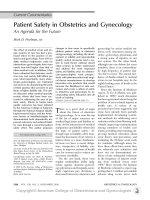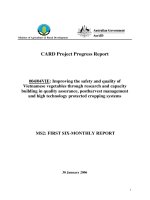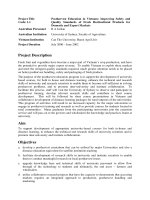Patient safety and quality improvement 101
Bạn đang xem bản rút gọn của tài liệu. Xem và tải ngay bản đầy đủ của tài liệu tại đây (2.16 MB, 81 trang )
Patient Safety and
Quality Improvement
101
GLOBAL HEALTH CONFERENCE
NOVEMBER 2020
Objectives
•To understand why Patient Safety and Quality
Improvement is foundational to today’s healthcare
delivery
•To know the meaning of the basic vocabulary of patient
safety/quality improvement
•To Understand the basic PS/QI methods
Traditional Patient Safety/Quality Improvement
“To Cure Sometimes
To Relieve Often
To Educate Unceasingly
To Comfort Always”
Overarching Aim for HC
•In the patient’s words: “They give me exactly the help I
need and want exactly when I need and want it”
•Thus the ideal 21st Century HC System evaluates the care
through the patient’s eyes
Why Bother with Pt Safety/Quality?
Do You Have an Ethical
Responsibility to Consistently
Provide Good Patient Care?
Is your community better off
because your healthcare facility is
present in it?
Questions to ask in Evaluating Healthcare
Outcomes – Evidence Based Medicine
1. What portion of your patients are receiving care in line
with current best practice (evidence-based medicine)?
2. How does the healthcare you provide need to change to
reflect best practice (evidence-based medicine)?
3. Do your healthcare professionals / managers have the
skills and support to make these necessary changes?
Which is the Most Dangerous?
How Hazardous is Health Care?
REGULATE
DANGEROUS
(>1/1000)
ULTRA-SAFE
(<1/100K)
100,000
Driving
10,000
Healthcare
1,000
Scheduled
Airlines
100
Mountain
Climbing
Bungee
Jumping
10
Chemical
Manufacturing
Chartered
Flights
European
Railroads
Nuclear
Power
1
1
10
100
1,000
10,000
100,000 1,000,000 10,000,00
0
Number of encounters for each fatality
Patient Safety
•HC has two implicit moral/ethical promises to patients that
entrust their care to us, we promise to:
•Do everything possible to help them
•Not hurt them
Patient Safety
•Patient Safety is the prevention of medical errors and
adverse events
•Integrating PS into practice is a very complex process in that
it interacts with both clinician practice and the institutional
“System”
•HC systems must be built on a “Culture of Safety”
• A system designed to prevent errors while empowering
individual staff members to promote safety and recognize and
respond to errors that occur
Patient Safety
•An 80-90% success rate to an institution sounds “great”
• But from a patients’ standpoint, it is unacceptable
• For the individual patient, reliability is an “all-or-none” matter
• Safety is Quality for an “n” of one
•Optimal Patient Safety requires a framework for improving
reliability - standardized protocols for care that are evidencebased and widely agreed upon is essential
Current Variation in Practice
• Study of Content of Care to Adults between 1996 and 1998:
•Only 55% of patients received “recommended” care (439
process-of-care measures)
• Up to 10,000 lives per year savable from pneumonia could be
prevented annually
•The “Gap” between what we know works and what is actually
done is so large it requires attention
McGlynn, Asch, Adams, Keesey, Hicks, De Christofaro and Kerr NEJM 348;(26) 2635-2645 June 26, 2003
Patient Safety – Systems Thinking
•No system will ever be able to “eliminate all errors.”
•A key principle: all patient safety programs that are
focused exclusively on eliminating errors will fail
•We are human. We will never eliminate all errors. The
real goal is to prevent harm to patients
•How: by taking a systems approach to problem solving
Medical Errors
•IOM Definition:
“The failure of a planned action to be completed as
intended or the use of a wrong plan to achieve an aim
(including problems in practice, products, procedures or
system)”
•“A Process that does not proceed the way it was intended
by its designers/managers”
• A more practical definition:
“Freedom from accidental injury due to medical care”
Patient Safety Errors
•Preventable harm is the third leading cause of death
•Medicine squanders ~ 30-40% of monies spent on HC
•Surgical instruments left in patients, overdoses in pediatric patients with
blood-thinners, Operates on the wrong side of the body, delivers
appropriate therapy (all of them) only about 55% of the time, and kills ~
100k per year.
• About 17% of hospitalized patients suffer a diagnostic error and ~ 7%
suffer a med error
The Swiss Cheese Model (Reason, 1991)
Latent
Failures
Triggers
Production
Pressures
Lack of
Attention
Zero fault
Procedures
Distractions
tolerance
Deferred
Mixed
Maintenance
Sporadic
Punitive
Messag
Training
policies
es
Clumsy
Technology
Defenses
Adverse
Event
Sentinel Event
An unexpected occurrence involving death or serious physical or
psychological injury, or the risk thereof
Serious injury includes loss of limb or function. “or the risk
thereof” includes any process variation for which a recurrence
would carry a significant chance of a serious adverse outcome
“Near Misses”
•"Near misses are the huge iceberg below the surface where all
the future errors are occurring”
•Close calls are given the same level of scrutiny as adverse events that
result in actual harm
• They are 3 to 300 times more common than actual adverse events
•A willingness and an way (means) to report problems is essential to safe care because you can’t fix
what you don’t know about
•As important, if not more important to evaluate a new miss
than evaluating an actual misadventure that resulted in patient
harm
Normal Response to a Medical Error
•Go directly to the staff members involved (the sharp end of the chisel)
• The Physician/medical residents
• The Nurse
•However, this is counter to a Safety Culture (“Just Culture”) concept:
• Do not automatically blames the caregiver
• Instead, thoroughly investigate the incident
• Root Cause Analysis:
• RCA is the process that seeks to explore all of the possible factors associated with
the incident by asking what happened, why it happened and what can be done to
prevent it from happening again
Just Culture
An atmosphere of trust in which people are encouraged
(even rewarded) for providing essential safety-related
information. Individuals trust that they will not be held
accountable for system failures; but, are also clear about
where the line must be drawn between acceptable and
unacceptable behavior
System Characteristics That Promote
a Culture of Patient Safety
•Culture Change: is it Safe to report adverse events?
•Simple: one-page (or less) report
•Share Feedback: in an Effective system – adverse events
are analyzed by experts and all share in feedback
Patient Safety and QI Gurus
•Walter Shewhart: first to describe the PDSA cycle and statistical control
•W. Edwards Deming: focus on process improvement, management has the final
responsibility for quality
• Special Causes of variation: unnecessary variation associated with specific causes:
equipment, people
• Common Causes of variation: those associated with systems aspects such as design,
training, machines or working conditions
•Joseph Juran: QI is a never-ending process, Quality goals must be specific
•Ishikawa/Taguchi: statistical techniques / quality tools
•Paul Betalden, Donald Berwick, Lucien Leape, and Brent James
The Catalyst
“To Err is Human” 1999
~ 98,000 preventable deaths
This was the “what”
“Crossing the Quality Chasm” 2001
Quality as a systems issue
This was the “how”
The Six Aims For Improvement
Safe
Effective
Patient-centered
Timely
Efficient
Equitable
Patient Safety Goals
1. Improve the accuracy of patient identification:
a. Two patient identifiers
b. “Time Out Process:” Prior to the start of any invasive
procedure conduct a final verification process to
confirm that all team members understand:
1.
2.
3.
4.
5.
You have the correct patient
You are doing the correct procedure
On the correct site,
With the availability of appropriate ancillary data
“Time-Out” is documented









